Semperivium Ruthenicum Koch Extract-Loaded Bio-Adhesive Formulation: A Novel Oral Antioxidant Delivery System for Oxidative Stress Reduction
Abstract
1. Introduction
2. Results
2.1. Total Polyphenol Content
2.2. 1H-NMR Spectroscopy
2.3. HPLC Assay
2.4. Xanthine Oxidase and Albumin Denaturation Inhibitory Activity
2.5. Bio-Adhesive Patch Evaluation
2.5.1. Mass Uniformity, Patch Thickness, and Flexibility
2.5.2. Surface pH and Swelling Index
2.5.3. Uniformity of Content
2.5.4. Ex-Vivo–Bio-Adhesive Strength
2.5.5. In Vitro Release Study
2.5.6. In Vivo Oral Antioxidant Effect
3. Discussion
4. Materials and Methods
4.1. Methods
4.1.1. Plant Extracts
4.1.2. Polymers and Reagents
4.2. Total Polyphenols Content Analysis
Plant Extracts Maximum Absorbance
4.3. 1H−NMR Spectroscopy
4.4. HPLC Assay
4.5. Xanthine Oxidase Inhibitory Activity
4.6. Albumin Denaturation Inhibitory Activity
4.7. Preparing the Bio-Adhesive Patches
4.8. Bio-Adhesive Patch Evaluation
4.8.1. Patch Surface pH
4.8.2. Uniformity of Content
4.8.3. Bio-Adhesive Patch Swelling Index
4.8.4. Determining the Bio-Adhesive Strength
4.8.5. In Vitro Release Study
4.8.6. Bio-Adhesive Patch In Vivo Antioxidant Activity
5. Conclusions
Author Contributions
Funding
Institutional Review Board Statement
Informed Consent Statement
Data Availability Statement
Conflicts of Interest
Appendix A
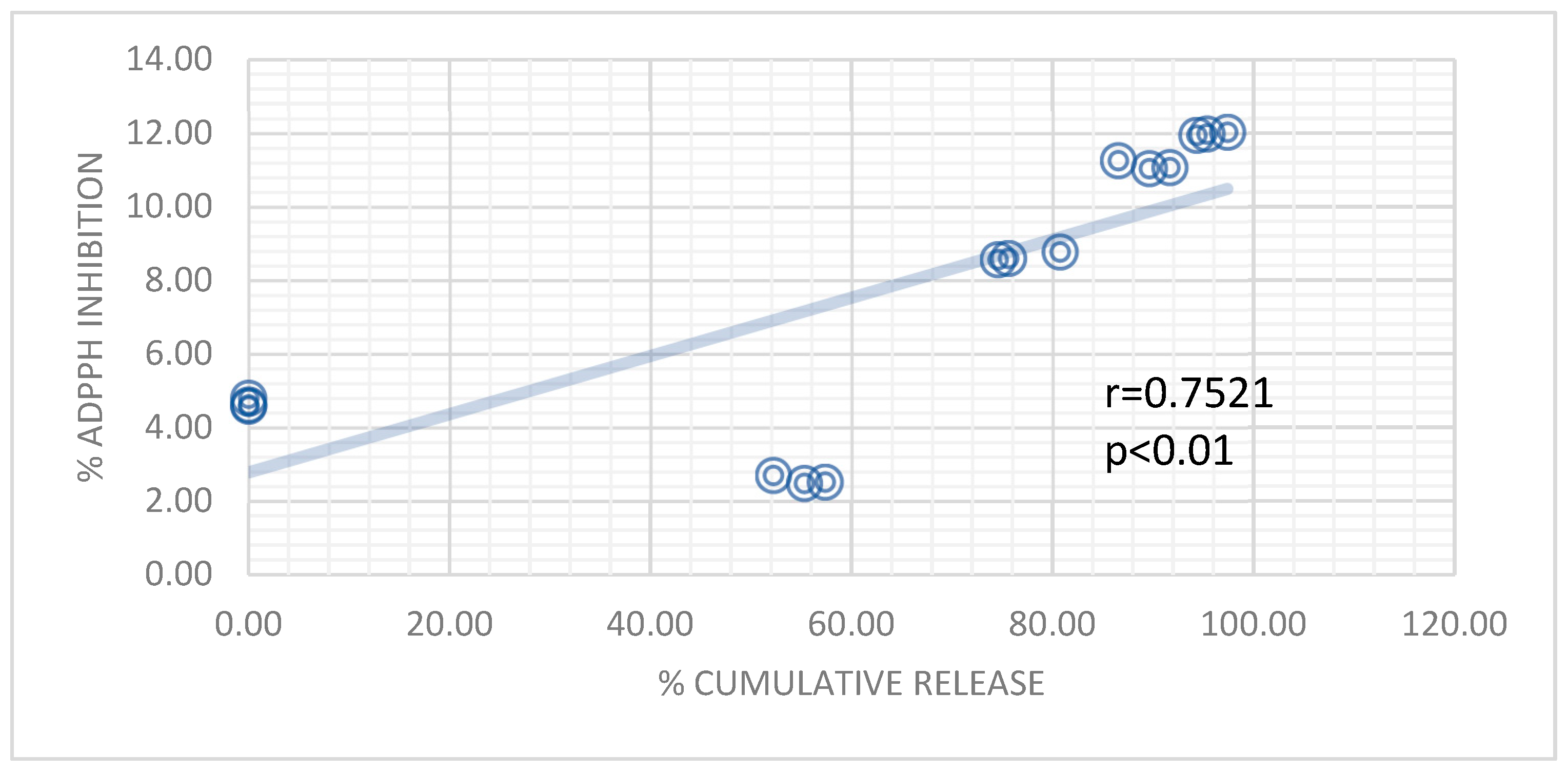

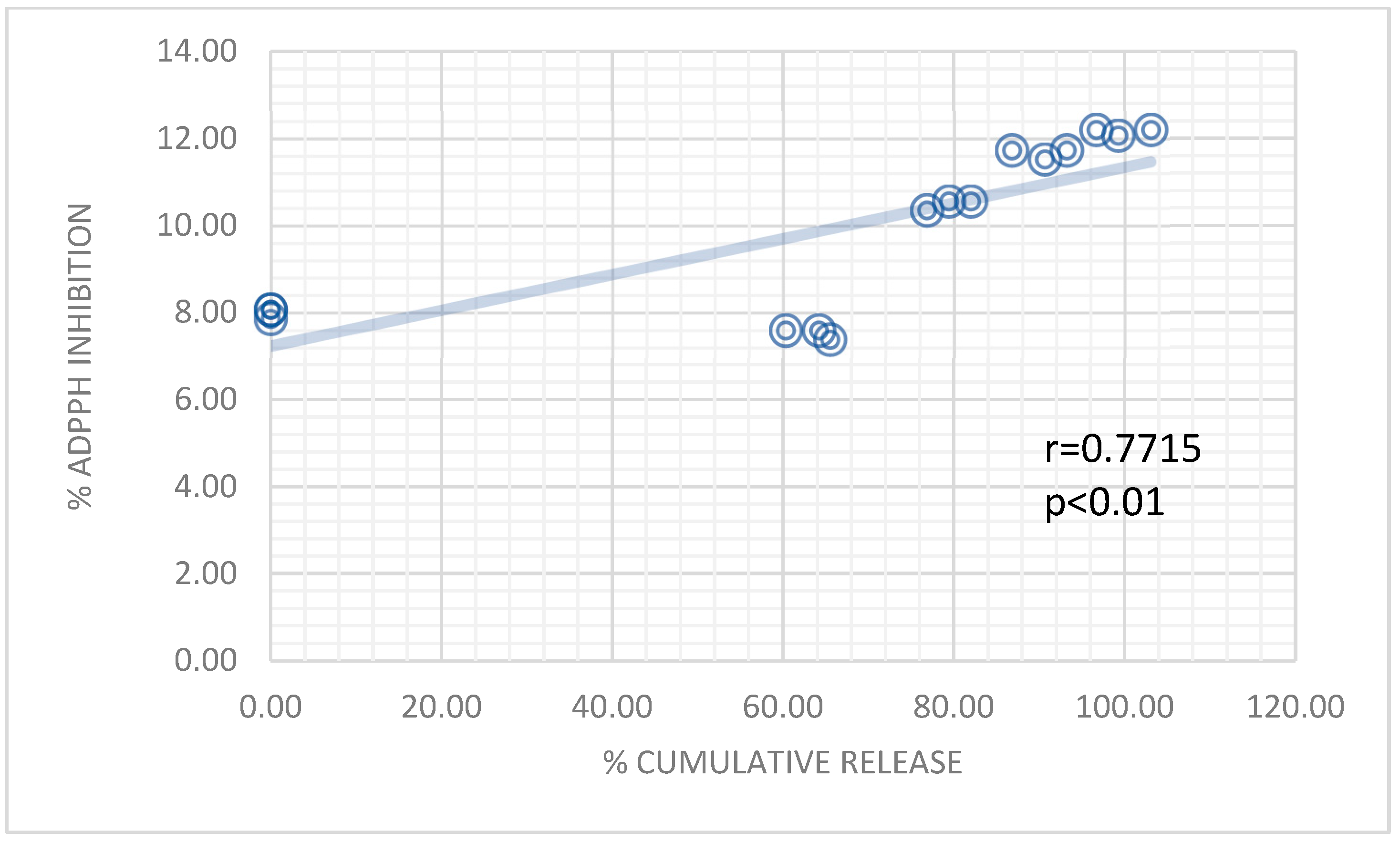
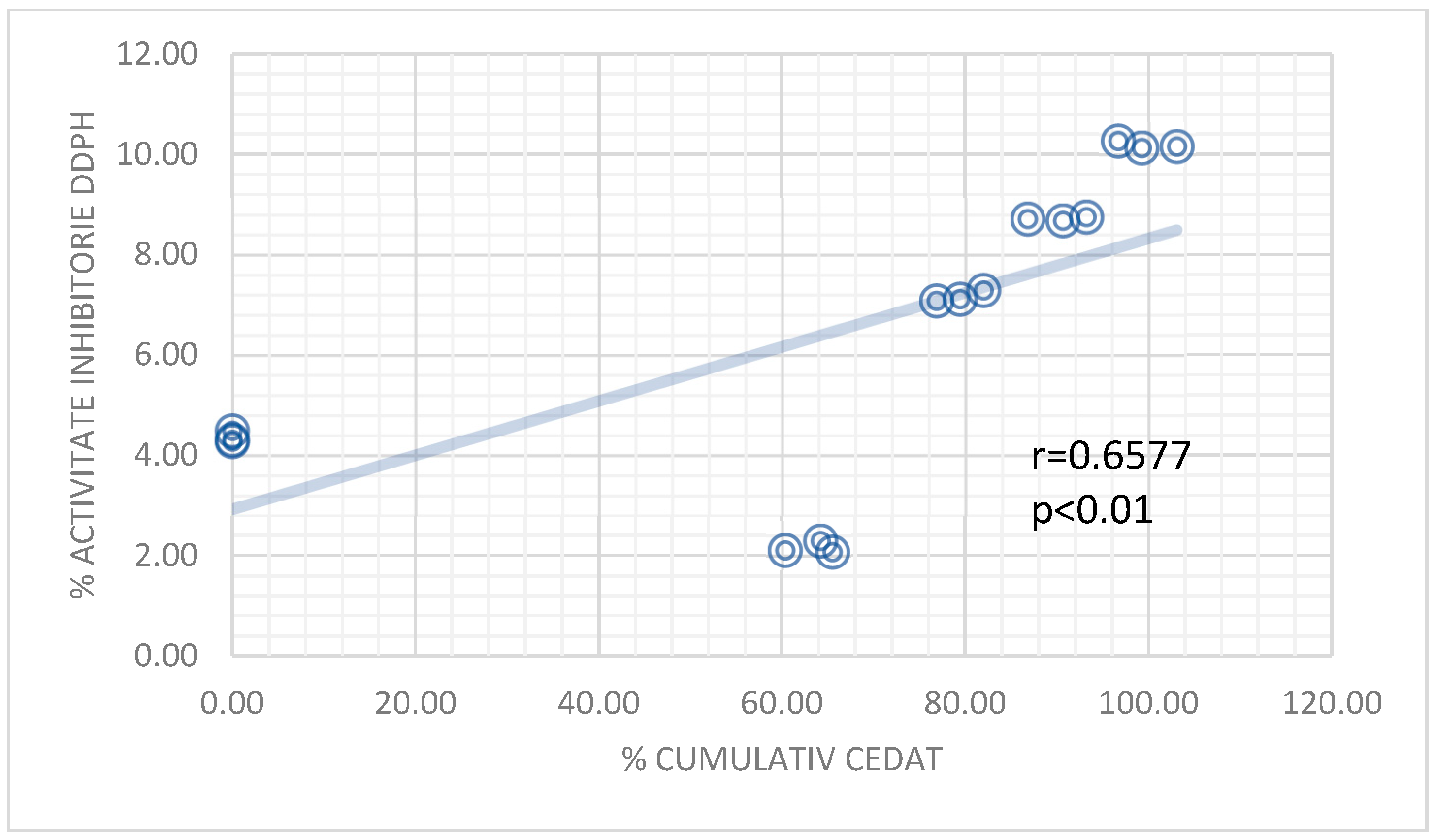
References
- Sender, R.; Fuchs, S.; Milo, R. Revised estimates for the number of human and bacteria cells in the body. PLoS Biol. 2016, 14, e1002533. [Google Scholar] [CrossRef]
- Blum, H.E. The human microbiome. Adv. Med. Sci. 2017, 62, 414–420. [Google Scholar] [CrossRef] [PubMed]
- Gevers, D.; Kugathasan, S.; Denson, L.A.; Vazquez-Baeza, Y.; Van Treuren, W.; Ren, B.; Schwager, E.; Knights, D.; Song, S.J.; Yassour, M.; et al. The treatment-naive microbiome in new-onset Crohn’s disease. Cell Host Microbe 2014, 15, 382–392. [Google Scholar] [CrossRef] [PubMed]
- Yachida, S.; Mizutani, S.; Shiroma, H.; Shiba, S.; Nakajima, T.; Sakamoto, T.; Watanabe, H.; Masuda, K.; Nishimoto, Y.; Kubo, M.; et al. Metagenomic and metabolomic analyses reveal distinct stage-specific phenotypes of the gut microbiota in colorectal cancer. Nat. Med. 2019, 25, 968–976. [Google Scholar] [CrossRef] [PubMed]
- Kitamoto, S.; Nagao-Kitamoto, H.; Hein, R.; Schmidt, T.M.; Kamada, N. The Bacterial Connection between the Oral Cavity and the Gut Diseases. J. Dent. Res. 2020, 99, 1021–1029. [Google Scholar] [CrossRef]
- Kamada, N.; Chen, G.Y.; Inohara, N.; Nunez, G. Control of pathogens and pathobionts by the gut microbiota. Nat. Immunol. 2013, 14, 685–690. [Google Scholar] [CrossRef]
- Kinane, D.F.; Stathopoulou, P.G.; Papapanou, P.N. Periodontal diseases. Nat. Rev. Dis. Primers 2017, 3, 17038. [Google Scholar] [CrossRef]
- Kinane, D.F.; Preshaw, P.M.; Loos, B.G.; Working Group 2 of Seventh European Workshop on Periodontology. Host response: Understanding the cellular and molecular mechanisms of host-microbial interactions—Consensus of the seventh European workshop on periodontology. J. Clin. Periodontol. 2011, 38, 44–48. [Google Scholar] [CrossRef]
- Laine, M.L.; Crielaard, W.; Loos, B.G. Genetic susceptibility to periodontitis. Periodontol. 2000 2012, 58, 37–68. [Google Scholar] [CrossRef]
- Chapple, I.L. Reactive oxygen species and antioxidants in inflammatory diseases. J. Clin. Periodontol. 1997, 24, 287–296. [Google Scholar] [CrossRef] [PubMed]
- Mittal, M.; Siddiqui, M.R.; Tran, K.; Reddy, S.P.; Malik, A.B. Reactive oxygen species in inflammation and tissue injury. Antioxid. Redox Signal. 2014, 20, 1126–1167. [Google Scholar] [CrossRef]
- Wang, Y.; Andrukhov, O.; Rausch-Fan, X. Oxidative stress and antioxidant system in periodontitis. Front. Physiol. 2017, 8, 910. [Google Scholar] [CrossRef] [PubMed]
- Lockhart, P.B.; Brennan, M.T.; Sasser, H.C.; Fox, P.C.; Paster, B.J.; Bahrani-Mougeot, F.K. Bacteremia associated with toothbrushing and dental extraction. Circulation 2008, 117, 3118–3125. [Google Scholar] [CrossRef] [PubMed]
- Parahitiyawa, N.B.; Jin, L.J.; Leung, W.K.; Yam, W.C.; Samaranayake, L.P. Microbiology of odontogenic bacteremia: Beyond endocarditis. Clin. Microbiol. Rev. 2009, 22, 46–64. [Google Scholar] [CrossRef]
- Tsukasaki, M.; Komatsu, N.; Nagashima, K.; Nitta, T.; Pluemsakunthai, W.; Shukunami, C.; Iwakura, Y.; Nakashima, T.; Okamoto, K.; Takayanagi, H. Host defense against oral microbiota by bone-damaging T cells. Nat. Commun. 2018, 9, 701. [Google Scholar] [CrossRef]
- Horliana, A.C.; Chambrone, L.; Foz, A.M.; Artese, H.P.; Rabelo, M.d.S.; Pannuti, C.M.; Romito, G.A. Dissemination of periodontal pathogens in the bloodstream after periodontal procedures: A systematic review. PLoS ONE 2014, 9, e98271. [Google Scholar] [CrossRef]
- Tagaino, R.; Washio, J.; Abiko, Y.; Tanda, N.; Sasaki, K.; Takahashi, N. Metabolic property of acetaldehyde production from ethanol and glucose by oral streptococcus and neisseria. Sci. Rep. 2019, 9, 10446. [Google Scholar] [CrossRef] [PubMed]
- Hajishengallis, G. Periodontitis: From microbial immune subversion to systemic inflammation. Nat. Rev. Immunol. 2015, 15, 30–44. [Google Scholar] [CrossRef]
- Desai, S.R.; Singh, P.; Simonelli, A.P.; Higuchi, W.I. Bioadhesive drug delivery systems: Progress, challenges, and perspectives. J. Control Release 2018, 280, 24–35. [Google Scholar]
- Al-Dulaijan, R.; Zayed, G.; Almalki, W.; Almohammadi, R.; Alfaifi, M.; Alomari, M.; Binmahfooz, A.; Alghamdi, H.; Alrabiah, M.; Alshehri, S.; et al. Development and evaluation of a bioadhesive chitosan-based gel containing an antioxidant for the treatment of periodontitis. J. Control Release 2021, 329, 1029–1037. [Google Scholar]
- Yadav, S.; Gupta, A.; Sharma, P.; Garg, T.; Goyal, A.K.; Rath, G. Development of mucoadhesive patch loaded with anti-inflammatory drug for the treatment of periodontitis. Int. J. Pharm. 2019, 556, 51–60. [Google Scholar]
- Binev, Y.; Marques, M.M.; Aires-de-Sousa, J. Prediction of 1H NMR coupling constants with associative neural networks trained for chemical shifts. J. Chem. Inf. Model. 2007, 47, 2089–2097. [Google Scholar] [CrossRef]
- Anastasiadi, M.; Zira, A.; Magiatis, P.; Haroutounian, S.A.; Skaltsounis, A.L.; Mikros, E. 1H NMR-Based metabonomics for the classification of greek wines according to variety, region, and vintage. Comparison with HPLC data. Aric. Food. Chem. 2009, 57, 11067–11074. [Google Scholar] [CrossRef]
- López-Martínez, L.M.; Santacruz-Ortega, H.; Navarro, R.-E.; Sotelo-Mundo, R.R.; González-Aguilar, G.A. A 1H NMR Investigation of the Interaction between Phenolic Acids Found in Mango (Manguifera indica cv Ataulfo) and Papaya (Carica papaya cv Maradol) and 1,1-diphenyl-2-picrylhydrazyl (DPPH) Free Radicals. PLoS ONE 2015, 10, e0140242. [Google Scholar] [CrossRef] [PubMed]
- Savage, A.; van Duynhoven, J.P.M.; Tucker, G.; Daykin, C.A. Enhanced NMR-based profiling of polyphenols in commercially available grape juices using solid-phase extraction. Magn. Reson. Chem. 2011, 49, s27–s36. [Google Scholar] [CrossRef] [PubMed]
- Kim, J.H.; Kim, T.B.; Yang, H.; Sung, S.H. Phenolic compounds isolated from Opuntia ficus-indica Fruits. Nat. Prod. Sci. 2016, 22, 117–121. [Google Scholar] [CrossRef]
- Mihai, S.; Popescu, A.; Raducanu, A.M.; Radu, M.D.; Badea, V. Phenolic profile and Antioxidant Activity of a Sempervivum ruthenicum Koch Ethanolic Extract. In Proceedings of the Nordsci Conference on Social Sciences, Helsinki, Finland, 17–19 July 2018. [Google Scholar]
- Mihai, S.; Dumitrescu, D.; Raducanu, A.M.; Stoicescu, I.; Badea, V. Phytochemical profile and total antioxidant capacity of Sempervivum ruthenicum Koch hydroethanolic extract. Rev. Chim. 2019, 70, 23–26. [Google Scholar] [CrossRef]
- Council of Europe. European Pharmacopoeia; Version 11.1; Council of Europe: Strasbourg, France, 2023; Available online: https://pheur.edqm.eu/home (accessed on 15 June 2023).
- Bruschi, M.L. Mathematical models of drug release. In Strategies to Modify the Drug Release from Pharmaceutical Systems; Woodhead Publishing: Sawston, UK, 2015; pp. 63–86. [Google Scholar]
- Mun, S.E.; Lee, J.Y.; Choi, J.S.; Park, J.H. Recent advances in bioadhesive drug delivery systems for mucosal route. Int. J. Biol. Macromol. 2021, 175, 60–77. [Google Scholar]
- Halliwell, B.; Whiteman, M. Measuring reactive species and oxidative damage in vivo and in cell culture: How should you do it and what do the results mean? Br. J. Pharmacol. 2004, 142, 231–255. [Google Scholar] [CrossRef]
- Kumar, P.; Subbannayya, Y. Proteomics-based insights into host-microbe interactions in periodontal disease. J. Proteom. 2021, 241, 104249. [Google Scholar]
- Ramineni, K. Mucoadhesive Films for Treatment of Local Oral Disorders: Development, Characterization and In Vivo Testing. Ph.D. Thesis, University of Kentucky, Lexington, KY, USA, 2014. No. 19. [Google Scholar]
- Zhong, Z.; Liang, S.; Sanchez-Lopez, E.; He, F. Recent advances in the research of the NLRP3 inflammasome in central nervous system disorders. Life Sci. 2020, 256, 117986. [Google Scholar]
- Hori, J.I.; Zamboni, D.S.; Carrao, D.B.; Goldman, G.H.; Berretta, A.A. The inhibition of inflammasome by Brazilian propolis (EPP-AF). Evid.-Based Complement. Alternat. Med. 2013, 2013, 418508. [Google Scholar] [CrossRef]
- Kelley, E.E.; Khoo, N.K.H.; Hundley, N.J.; Malik, U.Z.; Freeman, B.A.; Tarpey, M.M. Hydrogen peroxide is the major oxidant product of xanthine oxidase. Free Radic. Biol. Med. 2010, 48, 493–498. [Google Scholar] [CrossRef] [PubMed]
- Manvar, M.N.; Desai, T.R. Exploration of possible mechanisms for anti-inflammatory activity of Ipomoea aquatica Forsk. (Convolvulaceae). Int. J. Phytopharm. 2015, 5, 108–113. [Google Scholar]
- Adarsh, V.M.; Ajay, K.P.; Kavitha, D.; Anurag, K.B. Anti-Denaturation and antioxidant activities of Annona cherimola in vitro. Int. J. Pharma Bio. Sci. 2011, 2, 1–6. [Google Scholar]
- Moualek, I.; Iratni, G.; Guechoaoui, N.M.; Lahcene, S.; Houali, K. Antioxidant and anti-inflammatory activities of Arbutus unedo aqueous extract. Asian Pac. J. Trop. Biomed. 2016, 6, 937–944. [Google Scholar] [CrossRef]
- Chopade, A.R.; Somade, P.M.; Sayyad, F.J. Membrane stabilizing activity and protein denaturation: A possible mechanism of action for the anti-inflammatory activity of Phyllanthus amarus. J. Krishna Inst. Med. Sci. Univ. 2012, 1, 67–72. [Google Scholar]
- Kiranmayi, G.V.N.; Anusha, V.; Chandrika, Y.; Priya, I.V.S.; Swetha, S.; Krishna, V.Y. Preliminary phytochemical screening and in vitro evaluation of anti-inflammatory antiarthritic, and thrombolytic activities of ethanolic leaf extract of Bauhinia purpurea. Int. J. Green Pharm. 2018, 12, 248. [Google Scholar]
- Chandra, S.; Chatterjee, P.; Dey, P.; Bhattacharya, S. Evaluation of in vitro anti-inflammatory activity of coffee against denaturation of protein. Asian Pac. J. Trop. Biomed. 2012, 2, 178–180. [Google Scholar] [CrossRef]
- Marrassini, C.; Peralta, I.; Anesini, C. Comparative study of the polyphenol content-related anti-inflammatory and antioxidant activities of two Urera aurantiaca specimens from different geographical areas. Chin. Med. 2018, 13, 22. [Google Scholar] [CrossRef]
- Azadbakht, M.; Sariri, R.; Soltani, F.M.; Ghafoori, H.; Aghamaali, M.R.; Erfani Karimzadeh Toosi, A. Salivary antioxidant power of passive smokers. J. Nanomed. Biother. Discov. 2016, 6, 1000142. [Google Scholar]
- Nosratabadi, S.F.; Sariri, R.; Yaghmaei, P.; Taheri, M.; Ghadimi, A.; Ghafoori, H. Alternations of antioxidant activity in saliva in smokers. J. Phys. Theor. Chem. 2012, 8, 305–310. [Google Scholar]
- Belibasakis, G.N.; Bostanci, N. The oral-gut axis and its microbial inhabitants. Periodontol. 2000 2020, 83, 136–148. [Google Scholar] [CrossRef]
- Marchetti, E.; Tecco, S.; Santonico, M.; Di Natale, C.; Marzo, G. Detecting periodontal disease by sensing volatile organic compounds with metal oxide sensors. J. Periodontol. 2020, 91, 1165–1174. [Google Scholar]
- USP 30-NF25Pharmacopoeia; US Pharmacopeial Convention: Rockville, MD, USA, 2007; Volume 28, p. 914.
- Isa, S.S.P.M.; Ablat, A.; Mohamad, J. The antioxidant and xanthine oxidase inhibitory activity of Plumeria rubra flowers. Molecules 2018, 23, 400. [Google Scholar]
- Umamaheswari, M.; Madeswaran, A.; Asokkumar, K. Virtual screening analysis and in vitro xanthine oxidase inhibitory activity of some commercially available flavonoids. Iran. J. Pharm. Res. 2013, 12, 317–323. [Google Scholar]
- Khan, H.; Khan, M.A.; Rauf, A.; Haleemi, A.; Fuloria, S.; Fuloria, N.K. Inhibition on urease and thermal induced protein denaturation of commonly used antiulcer herbal products. Study based on in-vitro assays. Pharmacogn. J. 2015, 7, 147–152. [Google Scholar] [CrossRef]
- Hashemi, M.; Ramezani, V.; Seyedabadi, M.; Ranjbar, A.M.; Jafari, H.; Honarvar, M.; Fanaei, H. Formulation and optimization of oral mucoadhesive patches of Myrtus Communis by Box Behnken design. Adv. Pharm. Bull. 2017, 7, 441–450. [Google Scholar] [CrossRef]
- Bottenberg, P.; Cleymaet, R.; De Muynck, C.; Remon, J.P.; Coomans, D.; Michotte, Y.; Slop, D. Development and testing of bioadhesive, fluoride-containing slow-release tablets for oral use. J. Pharm. Pharmacol. 1991, 43, 457–464. [Google Scholar] [CrossRef]
- Gupta, A.; Garg, S.; Khre, R.K. Measurement of bioadhesive strength of mucoadhesive buccal tablet: Design of an in vitro assembly. Indian Drugs 1992, 30, 152–155. [Google Scholar]
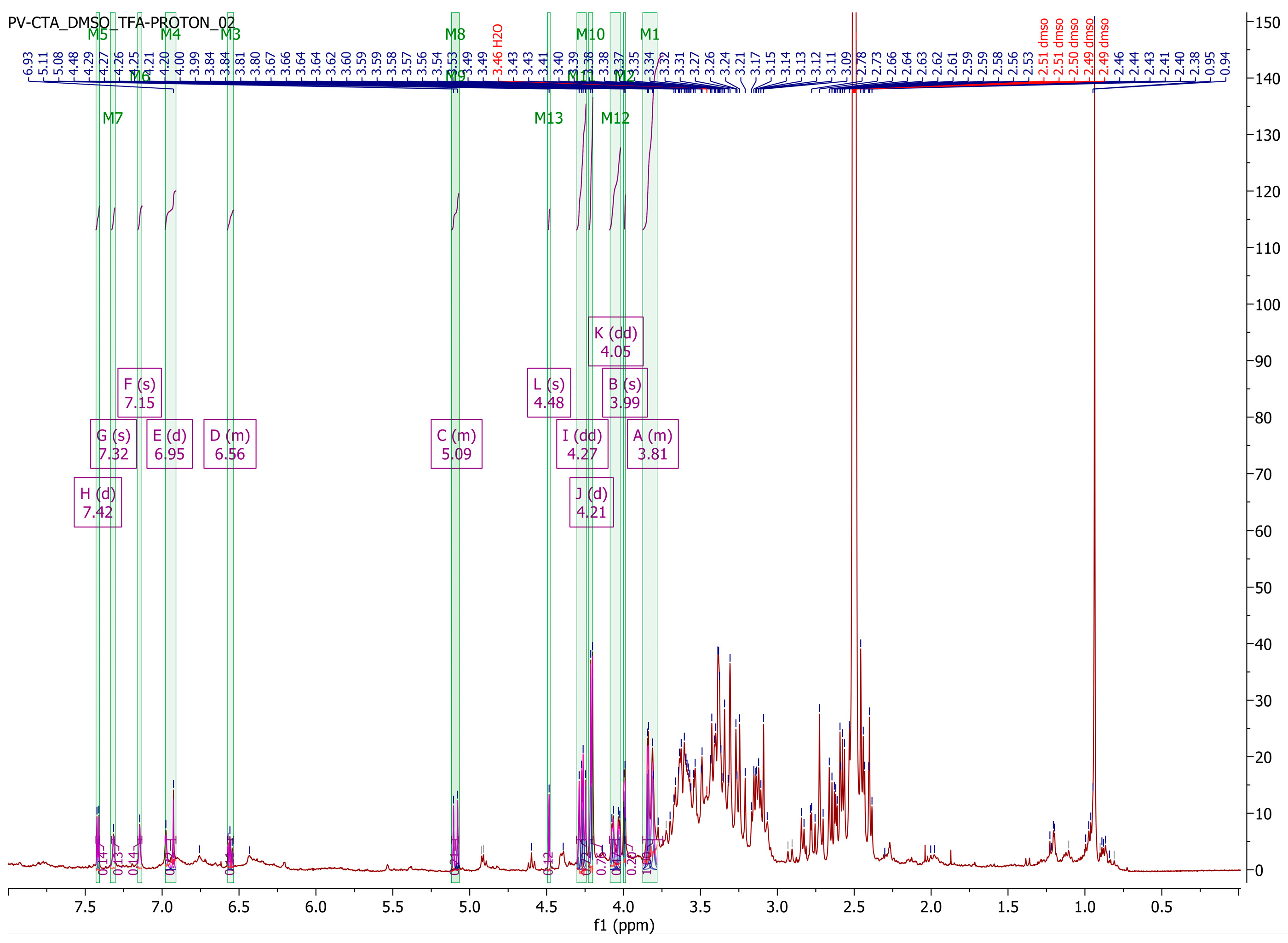
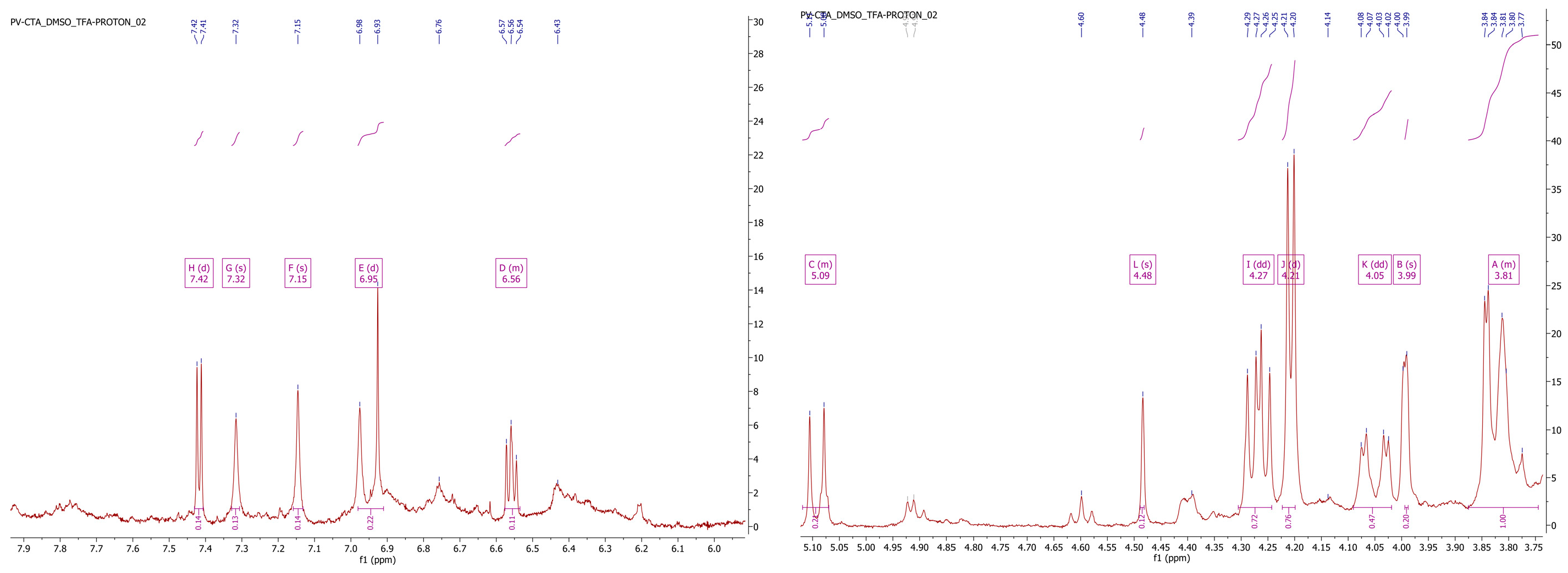
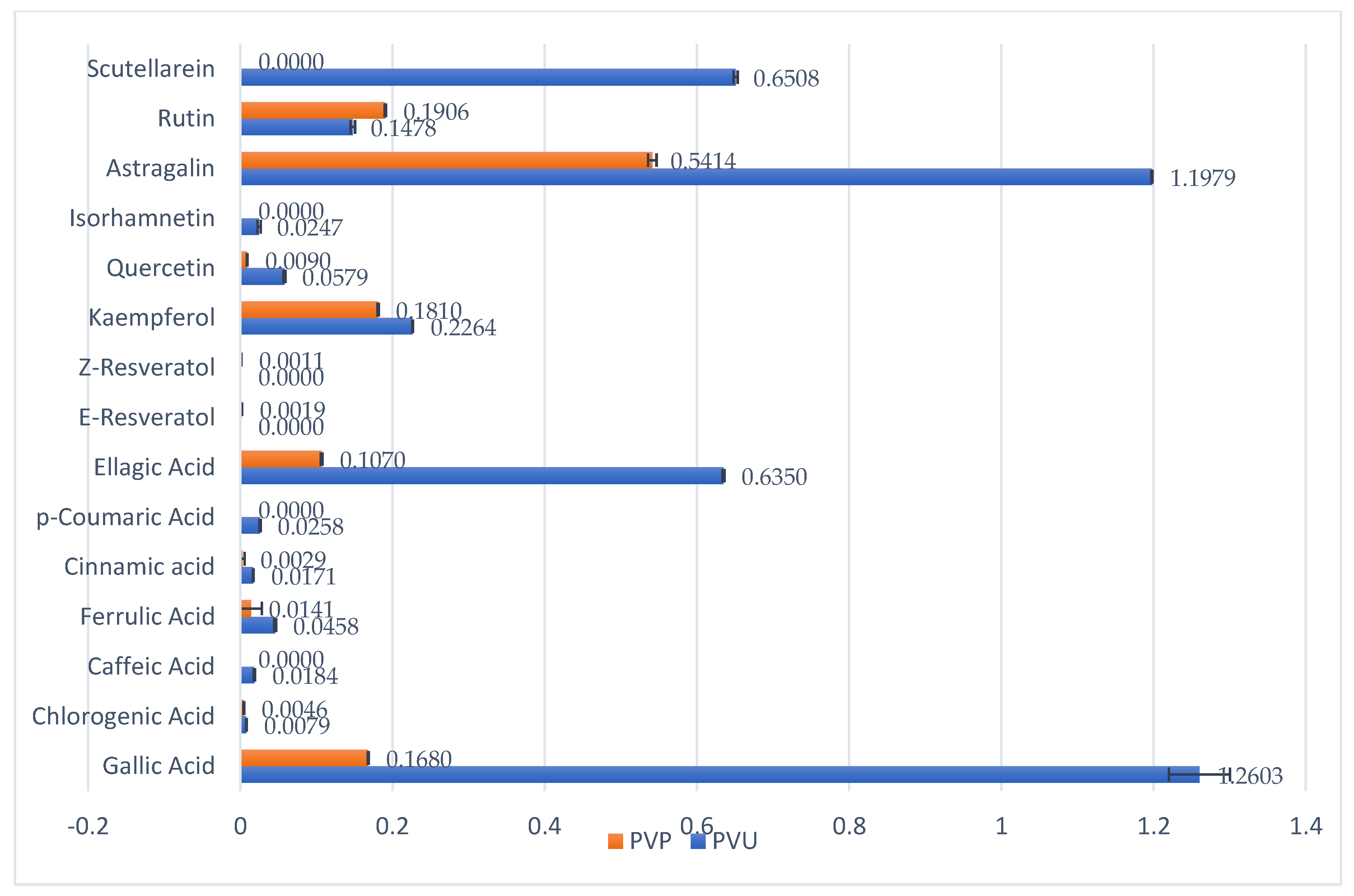

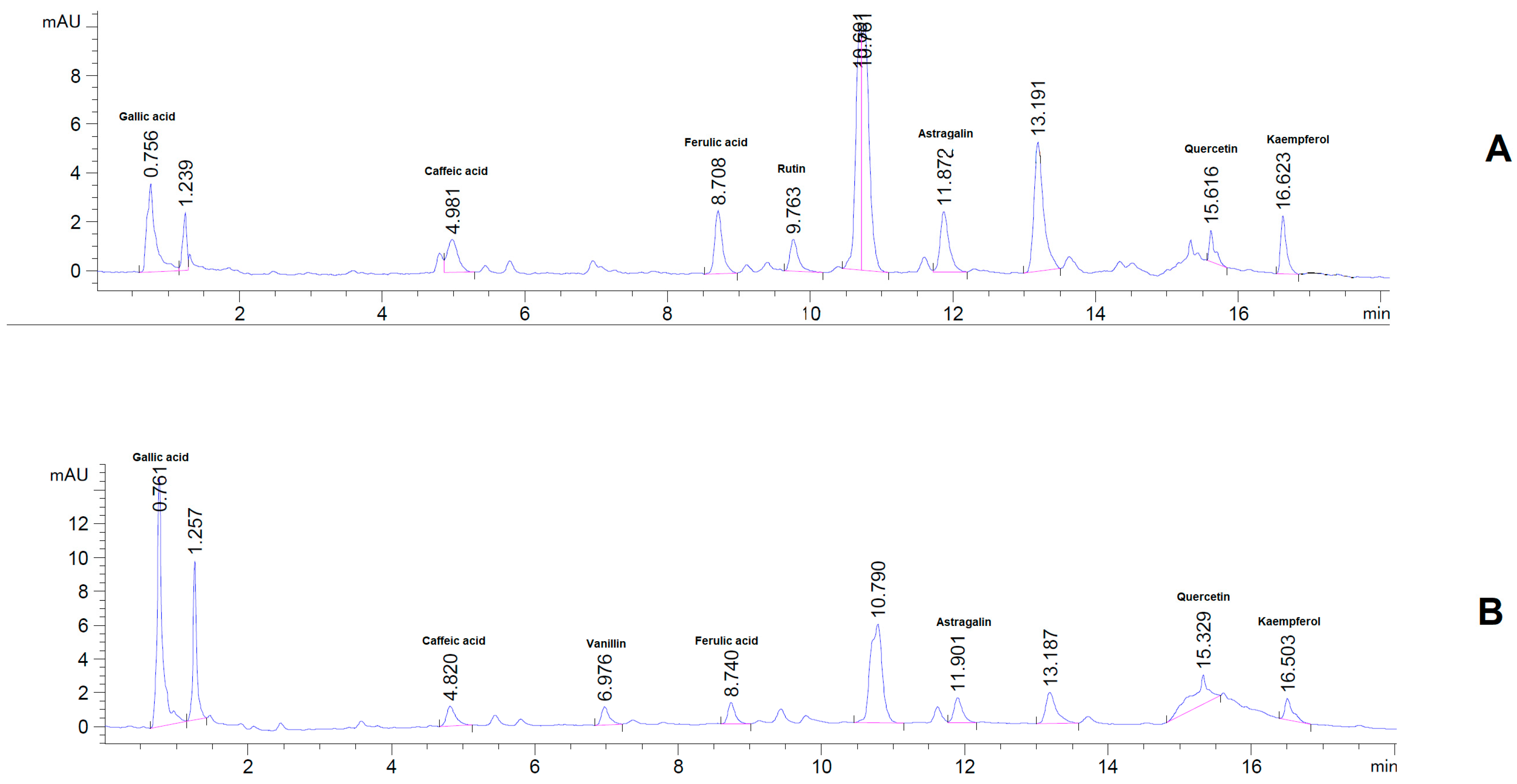
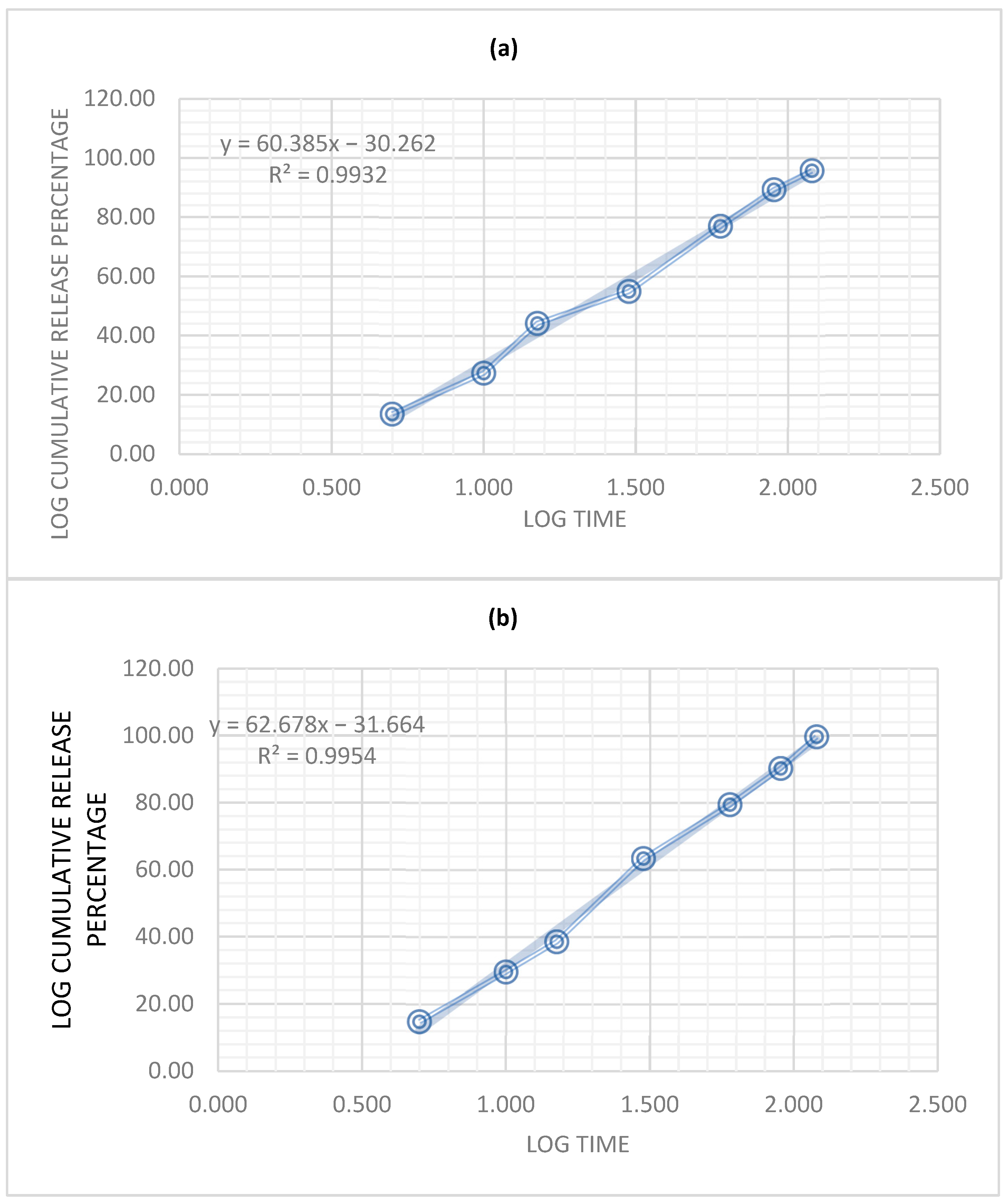
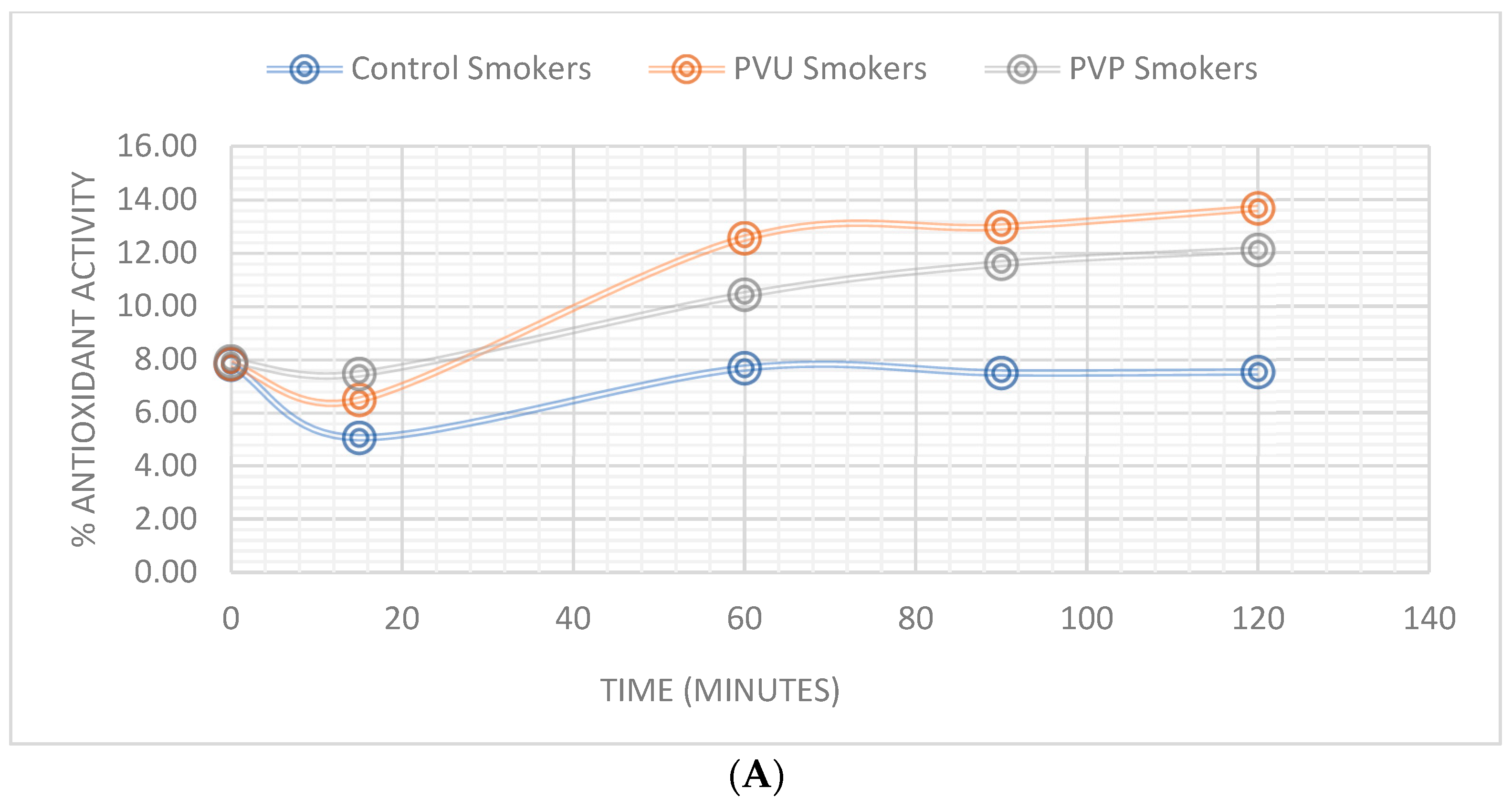
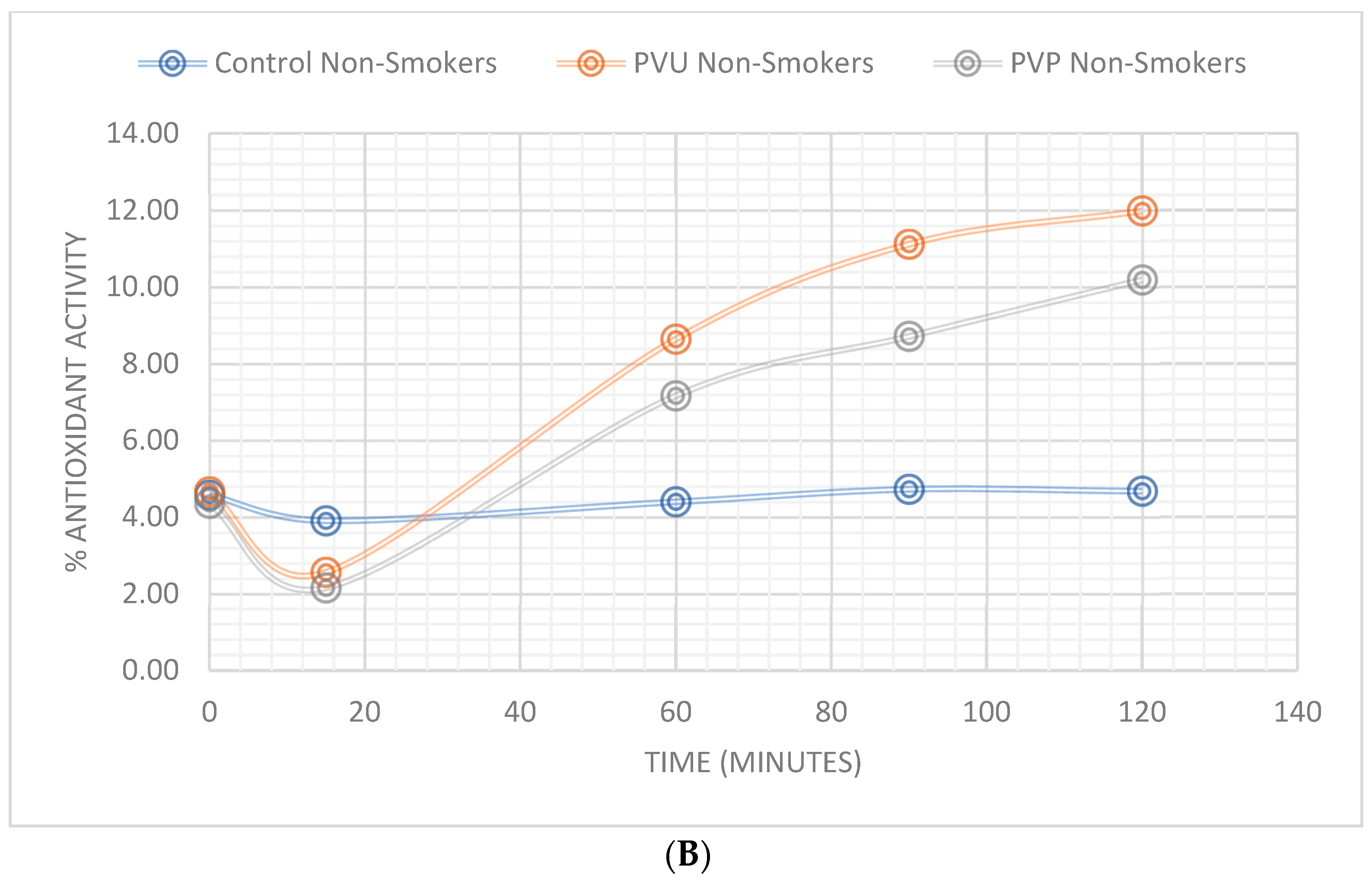
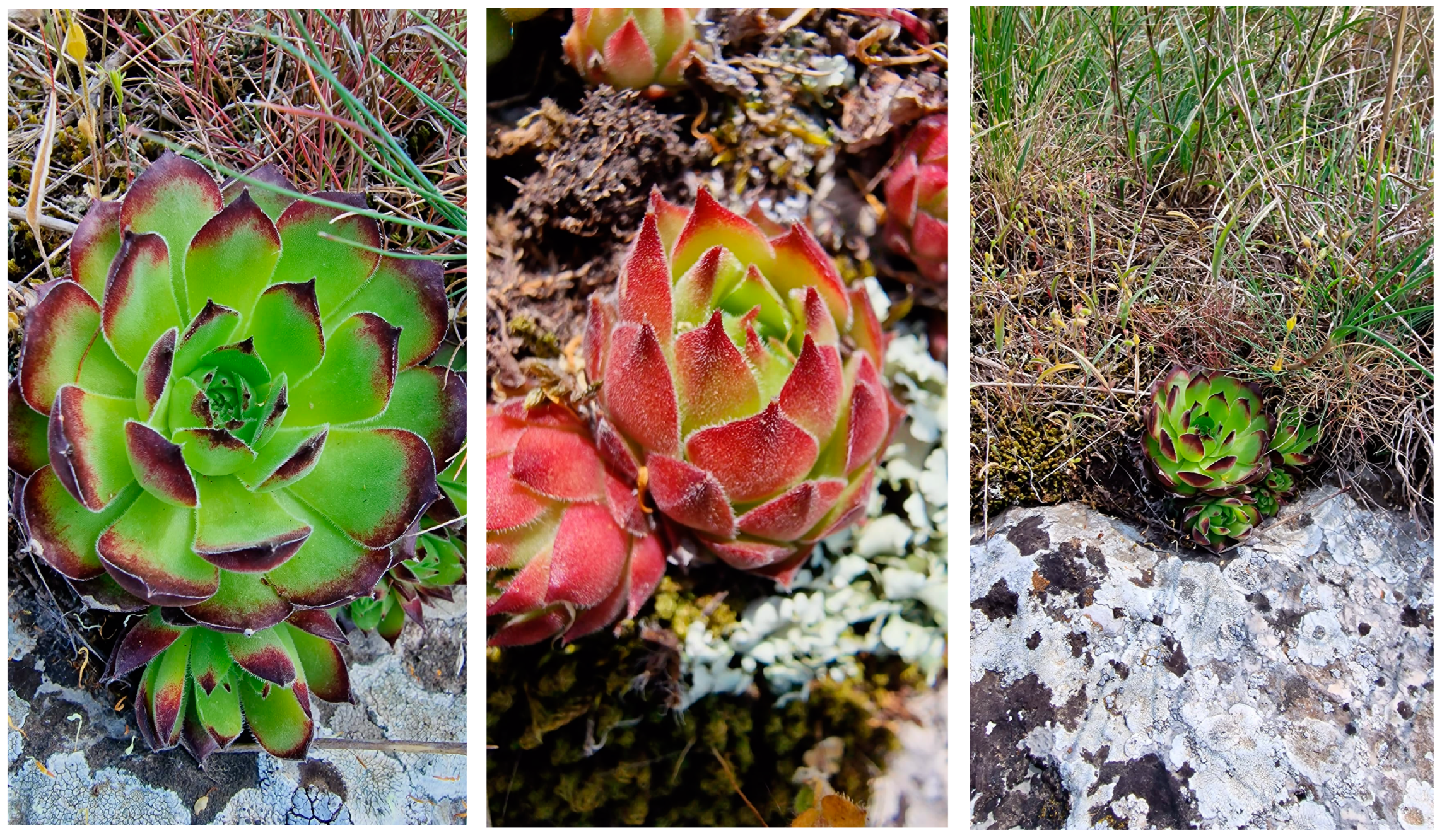
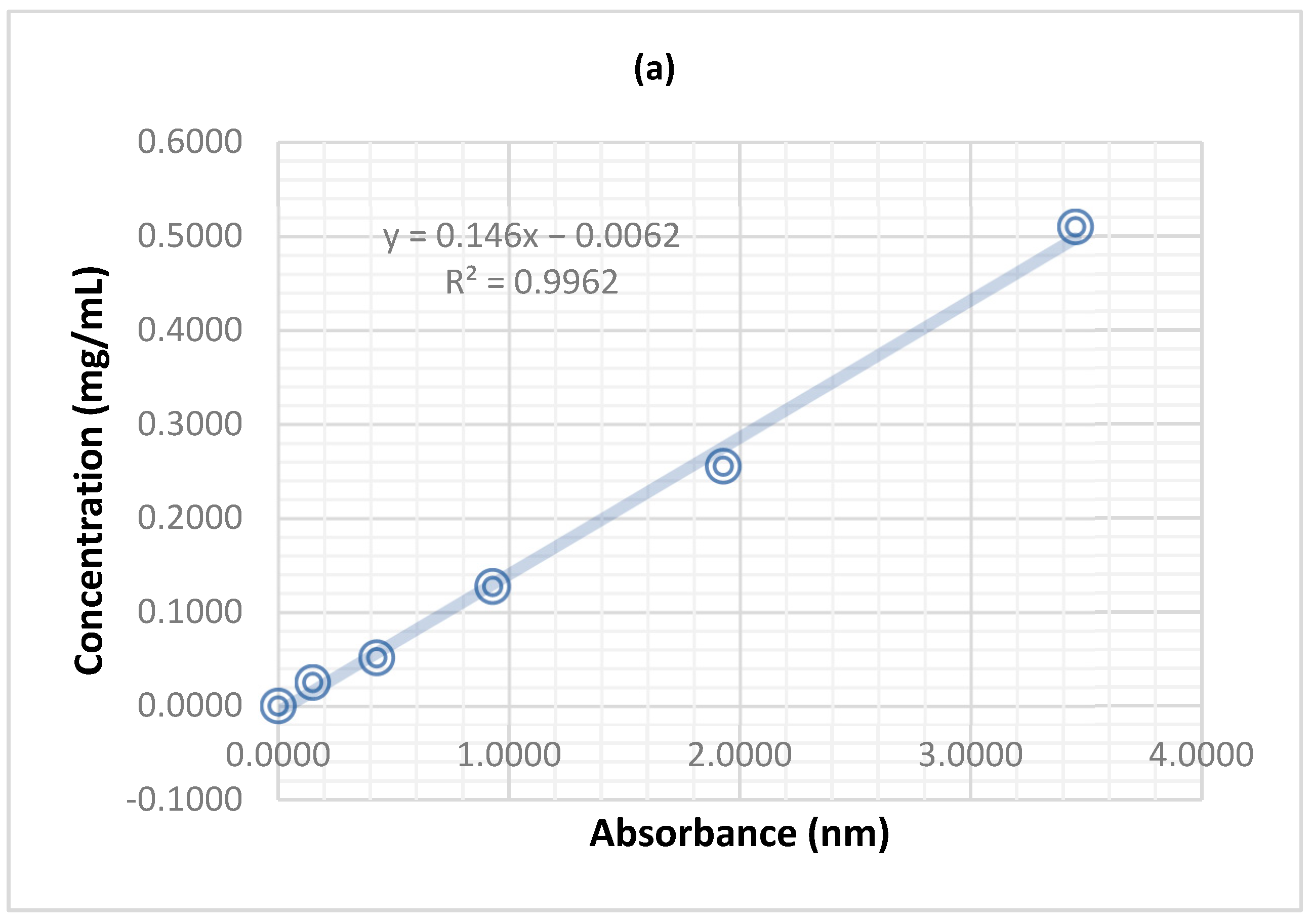


| Run No. | Polyphenol Content (mg PIR/mL) | Polyphenol Percentage to Dry Extract Weight | ||
|---|---|---|---|---|
| P1 | P2 | P1 | P2 | |
| 1 | 7.8330 | 2.2324 | 78.33 | 22.32 |
| 2 | 7.8691 | 2.1826 | 78.69 | 21.82 |
| 3 | 7.8844 | 2.1667 | 78.84 | 21.66 |
| Average | 7.8622 | 2.1939 | 78.62 | 21.93 |
| Standard deviation | 0.026 | 0.03 | 0.26 | 0.34 |
| Compound | Simulated Spectrum [22] * | Anastasiadi et al. [23] | Lopez-Martinez et al. [24] | Savage et al. [25] | Kim et al. [26] | Our Results |
|---|---|---|---|---|---|---|
| Gallic acid | δ 7.24 (2H, d) | 1H NMR: δ 7.08 (s, H2, H6) | 1H NMR: δ 6.91 (H2, H6) | 7.15 (s) | NA | δ 7.15 (s, H2, H6) |
| Syringic acid | δ 3.80 (6H, s), 7.26 (2H, d) | δ 7.32 (s, H2, H6), 3.87 (s, OMe3, OMe5) | NA | NA | NA | δ 3.99 (s, OMe), 7.32 (s, H2, H6) |
| Tartaric acid | 1H NMR: δ 4.94 (2H, d). | NA | NA | 4.36 (s) | NA | 4.48 (s) |
| Chlorogenic acid | δ 1.86 (1H, dd), 2.09 (1H, dd), 2.19–2.46 (2H, 2.26 (dd), 2.39 (dd)), 3.22–3.42 (2H, 3.27 (q,), 3.35 (dd)), 4.85 (1H, td), 6.50 (1H, d), 6.77 (1H, dd), 7.28 (1H, dd), 7.63–7.81 (2H, 7.69 (dd), 7.74 (d)). | NA | δ 6.99 (H2, H6), 7.42 (H-alfa), 3.91 (H1) | δ 3.88 (m), 6.96 (d), 7.15 (dd), | NA | δ 3.81 (m, H1), 6.56 (m, H-beta), 6.95 (d, H2, H6), 7.42 (d, H-alfa) |
| Caffeic acid | δ 6.45 (1H, d), 6.77 (1H, dd), 7.28 (1H, dd), 7.62–7.79 (2H, 7.68 (dd), 7.72 (d)). | δ 7.53 (d, H-alfa), 6.93 (dd, 6), | δ 6.96 (H2, H6), 7.41 (H-alfa) | NA | NA | δ 6.95 (d, H2, H6) 7.42 (d, H-alfa) |
| Ferulic Acid | δ 3.78 (3H, s), 6.45 (1H, d), 6.78 (1H, dd), 7.25 (1H, dd), 7.62–7.79 (2H, 7.68 (dd), 7.72 (d)). | δ, 6.47 (d, H-beta), 7.17 (d, H2), 7.67 (d H-alfa), 3.90 (s, OMe5) | δ 7.27 (H2, H6), 3.81 (H-OMe5), 7.48 (H-alfa), 6.36 (H-beta) | NA | NA | δ 3.99 (s, H-OMe5), 6.56 (m, H-beta), 7.15 (s, H-beta), 7.42 (d, H-alfa) |
| p-coumaric acid | δ 6.45 (1H, d), 6.90 (2H, ddd), 7.56 (2H, ddd), 7.74 (1H, d). | δ 7.45 (d, H2, H6), 6.80 (d, H3, H5) | δ 6.79 (H2, H6), 7.52 (H3, H5) | δ 6.94 (d), 7.58 (d) | NA | δ 6.95 (d, H2, H6), 7.42 (d, H2, H5) |
| Resveratrol | δ 6.17 (1H, dd), 6.75 (2H, dd), 6.93 (2H, ddd), 7.04–7.26 (4H, 7.11 (d), 7.18 (d), 7.20 (ddd)). | δ 7.35 (d, H2′, H6′), 6.45 (d, H2, H6) | NA | δ 6.67 (d), 6.92 (d), 6.96 (s), 7.14 (s) | NA | δ 7.15 (d, H2, H6) |
| Quercetin | δ 6.27 (1H, d), 6.44 (1H, d), 7.16 (2H, ddd), 7.47 (2H, ddd). | δ 7.74 (d, H2′), 7.64 (dd, H6′), | NA | NA | δ 7.53 (dd, H6′) | 7.42 (d, H6′) |
| Isorhamnetin | δ 3.80 (3H, s), 6.27 (1H, d), 6.44 (1H, d), 6.73 (1H, dd), 7.39 (1H, dd), 7.69 (1H, dd). | NA | NA | NA | δ 6.94 (1H, d, H-5′), 3.84 (3H, s, O-CH3); | δ 3.99 (s, H-OMe), 6.95 (d, H5′) |
| Polyphenolic Acids (mg/mL) | Flavonols (mg/mL) | Heterosides (mg/mL) | Flavones (mg/mL) | ||||||||||||
|---|---|---|---|---|---|---|---|---|---|---|---|---|---|---|---|
| Type of Extract | Gallic Acid | Chlorogenic Acid | Caffeic Acid | Ferrulic Acid | Cinnamic Acid | p-Coumaric Acid | Ellagic Acid | E-Resveratol | Z-Resveratol | Kaempferol | Quercetin | Isorhamnetin | Astragalin | Rutin | Scutellarein |
| P1 | 1.2603 ± 0.04 | 0.0079 ± 0.0004 | 0.0184 ± 0.0008 | 0.0457 ± 0.0012 | 0.0170 ± 0.0005 | 0.02575 ± 0.0009 | 0.6350 ± 0.0014 | * NA | * NA | 0.2264 ± 0.0003 | 0.0578 ± 0.0014 | 0.0247 ± 0.0021 | 1.1978 ± 0.0007 | 0.1478 ± 0.0029 | 0.6508 ± 0.0027 |
| P2 | 0.1679 ± 0.0007 | 0.0045 ± 0.0004 | * NA | 0.0140 ± 0.0141 | 0.0028 ± 0.0029 | * NA | 0.107025 ± 0.0011 | 0.0019 ± 0.0002 | 0.0011 ± 0.0001 | 0.181 ± 0.001 | 0.009 ± 0.0003 | * NA | 0.5414 ± 0.0055 | 0.1906 ± 0.001 | * NA |
| Inhibitory Activity (%) | |||||||
|---|---|---|---|---|---|---|---|
| Extract | 100 μg/mL | 80 μg/mL | 60 μg/mL | 50 μg/mL | 40 μg/mL | 20 μg/mL | IC50 μg/mL |
| P1 | 82.22 ± 0.45 | 72.74 ± 0.18 | 65.62 ± 0.28 | 63.63 ± 0.14 | 60.69 ± 0.68 | 53.52 ± 0.84 | 11.58 ± 0.36 |
| P2 | 92.70 ± 0.22 | 88.78 ± 0.27 | 74.50 ± 0.36 | 71.49 ± 0.26 | 66.70 ± 0.44 | 56.62 ± 0.59 | 5.977 ± 0.35 |
| Allopurinol | 99.78 ± 0.12 | 92.83 ± 0.22 | 82.07 ± 0.44 | 76.73 ± 0.22 | 70.82 ± 0.17 | 58.57 ± 0.78 | 0.927 ± 0.32 |
| Extract | Concentration μg/mL | IC50 | ||||
|---|---|---|---|---|---|---|
| 125 | 250 | 500 | 750 | 1000 | ||
| P1ET50 | 47.598 ± 0.235 | 56.910 ± 0.514 | 69.306 ± 0.942 | 83.066 ± 0.521 | 92.260 ± 0.155 | 138.84 ± 5.722 |
| P2ET50 | 47.361 ± 0.691 | 55.279 ± 0.714 | 66.548 ± 0.623 | 81.999 ± 0.896 | 92.052 ± 0.257 | 164.09 ± 9.916 |
| Acetylsalicylic acid | 35.973 ± 0.490 | 46.323 ± 0.420 | 59.282 ± 1.201 | 79.330 ± 1.990 | 92.734 ± 0.448 | 330 ± 7.821 |
| Formulation | Gallic Acid | Caffeic Acid | Ferulic Acid | Astragalin | Kaempferol | Quercetin | Rutin | Vanillin |
|---|---|---|---|---|---|---|---|---|
| P1 | 0.4696 ± 0.0031 | 0.0041 ± 0.0002 | 0.0067 ± 0.0002 | 0.4100 ± 0.0023 | 0.1484 ± 0.0009 | 0.0279 ± 0.0011 | 0.0755 ± 0.0021 | NA |
| P2 | 0.2497 ± 0.0027 | 0.0027 ± 0.0003 | 0.0029 ± 0.0003 | 0.2209 ± 0.0014 | 0.1001 ± 0.0012 | 0.5484 ± 0.0019 | NA | 0.0219 ± 0.0002 |
| % DPPH Inhibition (Average ± SD) | ||||||
|---|---|---|---|---|---|---|
| Smokers | Non-Smokers | |||||
| Time (Minutes) | Control | P1 | P2 | Control | P1 | P2 |
| 0 | 7.81 ± 0.11 | 7.83 ± 0.11 | 7.94 ± 0.11 | 4.57 ± 0.12 | 4.66 ± 0.12 | 4.35 ± 0.12 |
| 15 | 5.06 ± 0.12 | 6.48 ± 0.11 | 7.46 ± 0.11 | 3.91 ± 0.12 | 2.56 ± 0.12 | 2.15 ± 0.12 |
| 60 | 7.68 ± 0.11 | 12.56 ± 0.11 | 10.43 ± 0.11 | 4.40 ± 0.12 | 8.64 ± 0.11 | 7.16 ± 0.11 |
| 90 | 7.50 ± 0.1 | 12.98 ± 0.15 | 11.60 ± 0.11 | 4.73 ± 0.13 | 11.12 ± 0.12 | 8.71 ± 0.04 |
| 120 | 7.53 ± 0.12 | 13.68 ± 0.02 | 12.12 ± 0.07 | 4.67 ± 0.1 | 11.98 ± 0.04 | 10.18 ± 0.08 |
| P1 | P2 | ||
|---|---|---|---|
| Concentration (mg/mL) | Absorbance (290 nm) | Concentration (mg/mL) | Absorbance (215 nm) |
| 0.5100 | 3.4532 | 0.525 | 2.7961 |
| 0.2550 | 1.9281 | 0.35 | 2.0127 |
| 0.1270 | 0.9290 | 0.2625 | 1.5142 |
| 0.0510 | 0.4270 | 0.175 | 0.9128 |
| 0.0250 | 0.1493 | 0.131 | 0.6975 |
| 0.0000 | 0.0000 | 0 | 0 |
| Type of Extract | Methylcellulose (mg) | Gelatin (mg) | Polyvinylpyrrolidone (mg) | Pectin (mg) | Propylene Glycol (mg) | Plant Extract (mg) |
|---|---|---|---|---|---|---|
| P1 | 260 | 100 | 20 | 20 | 100 | 60 |
| P2 | 260 | 100 | 20 | 20 | 100 | 60 |
| Concentration (%) | 46.42 | 17.85 | 3.57 | 3.57 | 17.85 | 10.71 |
Disclaimer/Publisher’s Note: The statements, opinions and data contained in all publications are solely those of the individual author(s) and contributor(s) and not of MDPI and/or the editor(s). MDPI and/or the editor(s) disclaim responsibility for any injury to people or property resulting from any ideas, methods, instructions or products referred to in the content. |
© 2023 by the authors. Licensee MDPI, Basel, Switzerland. This article is an open access article distributed under the terms and conditions of the Creative Commons Attribution (CC BY) license (https://creativecommons.org/licenses/by/4.0/).
Share and Cite
Mihai, S.; Dumitrescu, D.E.; Popescu, A.; Stoicescu, I.; Matroud, N.; Răducanu, A.-M.; Mititelu, M. Semperivium Ruthenicum Koch Extract-Loaded Bio-Adhesive Formulation: A Novel Oral Antioxidant Delivery System for Oxidative Stress Reduction. Pharmaceuticals 2023, 16, 1110. https://doi.org/10.3390/ph16081110
Mihai S, Dumitrescu DE, Popescu A, Stoicescu I, Matroud N, Răducanu A-M, Mititelu M. Semperivium Ruthenicum Koch Extract-Loaded Bio-Adhesive Formulation: A Novel Oral Antioxidant Delivery System for Oxidative Stress Reduction. Pharmaceuticals. 2023; 16(8):1110. https://doi.org/10.3390/ph16081110
Chicago/Turabian StyleMihai, Sebastian, Denisa Elena Dumitrescu, Antoanela Popescu, Iuliana Stoicescu, Nadia Matroud, Ana-Mădălina Răducanu, and Magdalena Mititelu. 2023. "Semperivium Ruthenicum Koch Extract-Loaded Bio-Adhesive Formulation: A Novel Oral Antioxidant Delivery System for Oxidative Stress Reduction" Pharmaceuticals 16, no. 8: 1110. https://doi.org/10.3390/ph16081110
APA StyleMihai, S., Dumitrescu, D. E., Popescu, A., Stoicescu, I., Matroud, N., Răducanu, A.-M., & Mititelu, M. (2023). Semperivium Ruthenicum Koch Extract-Loaded Bio-Adhesive Formulation: A Novel Oral Antioxidant Delivery System for Oxidative Stress Reduction. Pharmaceuticals, 16(8), 1110. https://doi.org/10.3390/ph16081110







